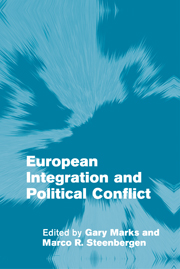Book contents
- Frontmatter
- Contents
- List of figures
- List of tables
- List of contributors
- Preface
- Introduction: Models of political conflict in the European Union
- Part I Citizens
- Part II Political parties
- Part III Groups
- 9 Contestation potential of interest groups in the EU: emergence, structure, and political alliances
- 10 Contestation in the streets: European protest and the emerging Euro-polity
- 11 Conclusion: European integration and political conflict
- References
- Index
11 - Conclusion: European integration and political conflict
Published online by Cambridge University Press: 22 September 2009
- Frontmatter
- Contents
- List of figures
- List of tables
- List of contributors
- Preface
- Introduction: Models of political conflict in the European Union
- Part I Citizens
- Part II Political parties
- Part III Groups
- 9 Contestation potential of interest groups in the EU: emergence, structure, and political alliances
- 10 Contestation in the streets: European protest and the emerging Euro-polity
- 11 Conclusion: European integration and political conflict
- References
- Index
Summary
Over the past half-century, Europe has experienced the most radical reallocation of authority that has ever taken place in peace-time, yet the ideological conflicts that will emerge from this are only now becoming apparent. This book originated in the efforts of a group of scholars to investigate the patterns of conflict – dimensions of contestation – that have arisen from European integration. The question that motivates us is a broad one: how does European integration play into the domestic politics of the member states? In this volume, we resolve this abstract question into a more precise and empirical one: to what extent and how are the issues arising from European integration connected to the dimensions of contestation that structure domestic politics? Is European integration assimilated within the major lines of conflict, above all the competition between left and right, or is it unrelated?
Rather than divide Europe by country, each of us examines one kind of group – citizens, national political parties, social movements, interest groups, members of the European Parliament, and European political parties – for the EU as a whole. We engage several kinds of data, including Eurobarometer surveys, party manifestos, expert evaluations of party positions, and elite interviews. We cannot claim to be of a single mind, but we do claim that we arrive at broadly consistent answers to our question. The aim of this chapter is to convey their substantive thrust.
- Type
- Chapter
- Information
- European Integration and Political Conflict , pp. 235 - 259Publisher: Cambridge University PressPrint publication year: 2004
- 39
- Cited by



